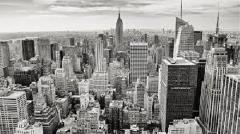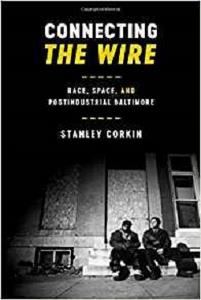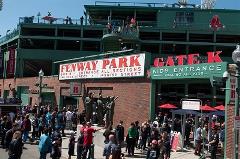Interview with Dr. Stanley Corkin
How Are Cities Defined?
Conducted by Rasha Aly
How do you see Boston? Do you see Boston as the small pub named Cheers where Sam Malone worked alongside Woody Boyd to serve regulars such as Norm Peterson and Frasier Crane? Or, is it the Red Sox winning the World Series in 2004 when the team, after 86 years, finally broke the Curse of the Bambino (Babe Ruth)? Perhaps, it is the racial struggle during the 1960s and 1970s busing crisis, where people still fought for desegregation of schools, a century after the Civil War, in what was a vibrant, multi-racial city?
9996cf95cb9e45e9bcdef4cfc7c6c12a.tmb-medium.png?sfvrsn=d1b48fb5_1)
Dr. Stanley Corkin, a professor with the departments of history and English & comparative literatures, would say each of these descriptions symbolizes Boston in a specific and different way. An expert at analyzing how different films and television shows represent geographic areas and their changing identities, Corkin has already written two books about the subject. The first, Starring New York: Filming the Grime and the Glamour of the Long 1970s (Oxford University Press, 2011), examines a range of films and how those films show the transformation of the Big Apple from a declining, industrial metropolis to a “global” capital of finance. His most recent book, Connecting The Wire: Race, Space, and Postindustrial Baltimore, Corkin looks at how The Wire, the well-acclaimed, HBO drama depicted the city of Baltimore.
For his fifth book, Imagining the New, New Boston, 1970-2016: History and Mass Culture in the Neoliberal Age, Corkin chose to focus upon the city of Boston. It is no surprise Corkin, a native Bostonian, chose that city to be his focal point in his third book in his three-book series. “I was interested in a second- or third-tier U.S. city hat had thrived notably in the post-industrial era,” Corkin said. “Boston made sense, because it had converted its educational infrastructure into economic successes, as well as employed that success to articulate a ‘brand’ through various media devices.”
Each of these three cities, New York, Baltimore, and Boston, represented major urban areas that conjured many significant definitions and images for people within society’s mass culture. Corkin said, “I have been long been concerned with questions of history and mass culture, and I decided to investigate the ways in which a mediated definition of ‘the urban’ had become an important issue in the age of neoliberalism, which creates an attendant network of world cities.”
“New York’s ‘success’ during this regime seemed notable. Similarly David Simon’s view of Baltimore as a city left behind offers a complement to that success, a means of filling in aspects of a larger picture. Then Boston’s emergent status as a relative financial and technology center provides a means of focusing on the ways in which material reality can work synergistically with media projects to create a sense of place that is attractive and saleable,” Corkin said.
The Big Apple
As the Moshulu, a four-masted, steel, enters the New York City Harbor in 1901, the ship, which is carrying a group of Italian immigrant, passes in front of the Statue of Liberty. Inside Ellis Island, the intake officer calls for the next person in line. “What is your name? Come on son, What is your name?” A young 9-year-old boy, in gray pants and buttoned-up shirt, wearing a Gatsby cap, looks up at the officer and says nothing. The young, Italian child does not know much English.
 The translator asks in Italian, “What is your name,” and then reads the tag on the young boy’s coat. The tag reads, “VITO Andolini from Coreolone. Thus, the young boy is named Vito Corleone – the same Vito Coreleone, who will later become the Mafia boss known as the Godfather in the movie of the same name. Coreleone works hard to become a successful “businessman” in the United States, and as he does this, he becomes a force to be reckoned with in New York City’s Little Italy. In his third book, Corkin concentrates mainly on how Hollywood connected to New York City by studying more than 20 films that were set and shot within the city. As he watched these films, Corkin uses these movies to show how these movies are tools of urban discourse. These films help show viewers the different factors that surrounded each of the Big Apple’s major, urban transformations. To outline his findings, Corkin had divided the book into six sections, and each of these sections illustrate how a group of films related to certain urban themes along with historical milestones.
The translator asks in Italian, “What is your name,” and then reads the tag on the young boy’s coat. The tag reads, “VITO Andolini from Coreolone. Thus, the young boy is named Vito Corleone – the same Vito Coreleone, who will later become the Mafia boss known as the Godfather in the movie of the same name. Coreleone works hard to become a successful “businessman” in the United States, and as he does this, he becomes a force to be reckoned with in New York City’s Little Italy. In his third book, Corkin concentrates mainly on how Hollywood connected to New York City by studying more than 20 films that were set and shot within the city. As he watched these films, Corkin uses these movies to show how these movies are tools of urban discourse. These films help show viewers the different factors that surrounded each of the Big Apple’s major, urban transformations. To outline his findings, Corkin had divided the book into six sections, and each of these sections illustrate how a group of films related to certain urban themes along with historical milestones.
The second section, which featured parts one and two of the Godfather trilogy, show how racialized neighborhoods influenced the transformation of New York City. Corkin, who also added in an analysis ofthe movie, Mean Streets, gives an in-depth breakdown of how ethnic and racialized geographies, such as Little Italy and Harlem, influence New York City in chapters three and four of the book. Other parts of the book examined how the economicdeterioration of the cit1234 123412341234y, how urban crime connected to the emergence of neo-liberalism and neo-conservatism within the city and the nation as a whole. For instance, Corkin detailed how movies, such as The French Connection and the Prince of the City no longer saw New York as a city limited to contact with only other American cities but more as a worldly city with a number of international connections.
The Wire
In the first scene, Snot Boogie, a small-time, West-Baltimore druggie, lays on the street dead, as the police canvass the area. On the sidewalk, next to the crime scene, Detective James “Jimmy” McNulty is talking to a random guy about Snot
McNulty asked this stranger, “If every time Snotboogie would grab the money and run away, why’d you even let him in the game?”
The stranger replied, “Got to. This America, man.”
 The stranger’s response showed that in America, people believe that everyone should have the opportunity to “play the game.” However, what is contradictory about the statement is that most of West Baltimore residents, especially due to their environment and the opportunities that surrounded them – do not have much opportunity at all. Instead, choose to seize the limited opportunities available: they became involved in crime. The drama series’ plots are a very-close-to-reality narrative of the experiences and space many West Baltimore African Americans face – experiences where this community do whatever they need to do to survive – including breaking the law. It is this emphasis on the specific neighborhood of West Baltimore that Corkin finds interesting and elaborates upon throughout his fourth monograph. While his third book concentrated upon the entire city of New York, the Wire focuses upon the same, inner-city, poor neighborhood. Corkin highlights the variety of factors that continue to cause the residents of this geographic location to drown in crime and poverty. Corkin writes in his newest book that The Wire “opens a discussion substantially focused on how urban despair is created and enabled by the institutional structures that articulate the terms and limits of ghetto life. Drugs are not so much the catalyst for misery as a symptom of the extremes of inequality and social isolation” (p. 7). Throughout the five-season series, David Simon, the show’s producer and a former Baltimore Sun reporter, provides examples of structural factors that contribute to the inequality and social isolation, and these factors include the unequal education the children, who live in that neighborhood receive; the unemployment that permeates the neighborhood; and the policies that contribute to the decline of jobs in the neighborhood, among another of other factors.
The stranger’s response showed that in America, people believe that everyone should have the opportunity to “play the game.” However, what is contradictory about the statement is that most of West Baltimore residents, especially due to their environment and the opportunities that surrounded them – do not have much opportunity at all. Instead, choose to seize the limited opportunities available: they became involved in crime. The drama series’ plots are a very-close-to-reality narrative of the experiences and space many West Baltimore African Americans face – experiences where this community do whatever they need to do to survive – including breaking the law. It is this emphasis on the specific neighborhood of West Baltimore that Corkin finds interesting and elaborates upon throughout his fourth monograph. While his third book concentrated upon the entire city of New York, the Wire focuses upon the same, inner-city, poor neighborhood. Corkin highlights the variety of factors that continue to cause the residents of this geographic location to drown in crime and poverty. Corkin writes in his newest book that The Wire “opens a discussion substantially focused on how urban despair is created and enabled by the institutional structures that articulate the terms and limits of ghetto life. Drugs are not so much the catalyst for misery as a symptom of the extremes of inequality and social isolation” (p. 7). Throughout the five-season series, David Simon, the show’s producer and a former Baltimore Sun reporter, provides examples of structural factors that contribute to the inequality and social isolation, and these factors include the unequal education the children, who live in that neighborhood receive; the unemployment that permeates the neighborhood; and the policies that contribute to the decline of jobs in the neighborhood, among another of other factors.
Boston
Movies are not the only elements that help invoke images of a city’s identities in today’s society. Through his research, Corkin has realized there are other factors, besides Hollywood, that contribute to a city’s public identity. In his latest book, he is using more than just film and shows to study the different Boston identities in his most recent book project. He is taking more of a broader approach, by examining how other culture factors, such as sports and media, represent these identities too, but Corkin is also still focusing on one geographic space: Boston. “In the study, I delve into the meanings of ‘Boston’ from 1970 to the present, an inquiry into the realm of mass culture that explores the intersections of the city’s post-industrial history and meanings – topics that are related but divergent,” Corkin wrote in the proposal he submitted for the Center Fellowship.
 In Boston, an example of another factor that influences Boston’s image in society is the city’s sports teams. The Red Sox baseball team is intimately linked with the city’s identity. Boston residents would say you are not a true Bostonian unless you root for the Red Sox. Even when the baseball team faced the Bambino curse, the 86-year drought where the Reds never won a World Series from 1918 to 2004, the fans still filled Fenway Boston Park. “We picked the Red Sox because they lose,” late-night talk show host Jimmy Fallon once said. “If you root for something that loses for 86 years, you’re a pretty good fan. You don’t have to win everything to be a fan of something.”
In Boston, an example of another factor that influences Boston’s image in society is the city’s sports teams. The Red Sox baseball team is intimately linked with the city’s identity. Boston residents would say you are not a true Bostonian unless you root for the Red Sox. Even when the baseball team faced the Bambino curse, the 86-year drought where the Reds never won a World Series from 1918 to 2004, the fans still filled Fenway Boston Park. “We picked the Red Sox because they lose,” late-night talk show host Jimmy Fallon once said. “If you root for something that loses for 86 years, you’re a pretty good fan. You don’t have to win everything to be a fan of something.”
Therefore, when the team accomplishes an amazing feat, like breaking the Curse of the Bambino in 2004, the city of Boston conjures up images linked with pride. In addition, however, when Red Sox fans throw a barrage of racist insults at Orioles All-Star baseball player Adam Jones, these actions surrounding the Red Sox invoke thoughts that Boston is a racist city. When a famous baseball player such as Barry Bonds, a seven-time National League MVP award-winner who played for the Pittsburgh Pirates and the San Francisco Giants, would say, “Boston is to racist for [him]. [He] couldn’t play there. That’s been going on ever since my dad[1] was playing baseball. I can’t play like that. That’s not for me, brother.”
In his research, Corkin will look at how Boston sports teams, such as the Red Sox, and how these teams have influenced Boston’s portrayal in society. In addition, he will look at how news, such as the Boston Marathon bombing, which happened on April 15, 2013, and the Boston busing crisis in the 1960s and 1970s, has shaped Boston’s identity as well. Along with these factors, Corkin will continue exploring the Hollywood influence by examining Boston-thematic movies such as The Friends of Eddie Coyle (1973), The Brinks Job (1978), Good Will Hunting (1997), The Departed (2006), and Gone, Baby, Gone(2007). He will also be analyzing Boston-themed television shows, such as St. Elsewhereand Ray Donovan, to contribute to his study.
Conclusion
One difference readers may see in his last book is more of a focus on inequality. His NEW YORK- book focused a lot more on the structures that caused inequality, because The Wire focused on a specific neighborhood where most of the inhabitants lived in poverty. Corkin said he would like “to open up a more analytical vision of the forces that animate contemporary relationships of inequality.”
Corkin will be using his year as a Center Fellow to finish his last book in the trilogy. He has already drafted three of the six chapters that will form the body of his study.
[1] Barry Bonds father is Bobby Bonds, who is also a former major leaguer.